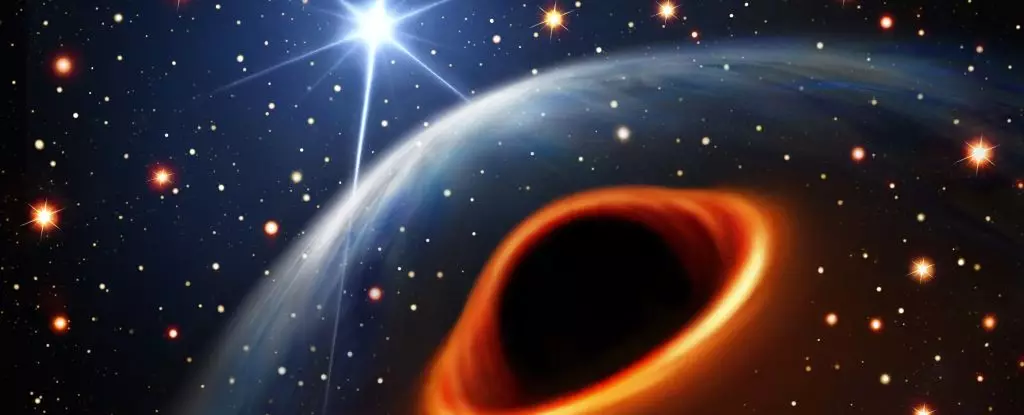In the vast expanses of the universe, pivotal discoveries often emerge as enigmas, challenging established scientific norms and expanding our understanding of cosmic phenomena. Recently, astronomers have unveiled one such mystery involving a red giant star situated approximately 5,825 light-years from Earth. This star, seemingly tangled in a slow orbital waltz, is behaving in a manner indicative of a binary system; however, it harbors a conspicuous absence—a binary companion that emits no detectable light. This peculiar scenario has led a team of astronomers, spearheaded by Song Wang from the Chinese Academy of Sciences, to propose an astonishing possibility: the presence of a low-mass black hole, specifically one that exists within the elusive realm known as the “mass gap.”
The Characteristics of the Stellar Dance
Dubbed G3425, the red giant exhibits uncharacteristic movements that suggest it is engaged in a gravitational partnership with an unseen celestial body, which has been inferred to possess a mass approximately 3.6 times that of our Sun. Significantly, this mass falls within a range often referred to as the mass gap, a mysterious void in the known spectrum of black hole sizes. Unlike their more massive counterparts, black holes in this category, particularly those under five solar masses, have remained largely undetectable, raising compelling questions regarding their formation and existence. The peculiar dynamics of G3425’s orbit, characterized by a stable, circular path lasting around 880 days, stand in stark contrast to what current astrophysical models suggest. Binary systems generated from supernova events, the cataclysmic deaths of massive stars, typically result in considerable disturbances, leading to elliptical orbits. Thus, G3425’s behavior invites intense scrutiny and suggests a more complex evolutionary history.
The Significance of the Mass Gap
Black holes are remnants of massive stellar cores that have exhausted their nuclear fuel and succumbed to gravitational collapse. They exist on a continuum of density, beginning with white dwarfs formed from stars of up to eight solar masses, followed by neutron stars with masses approaching 2.3 solar masses. Beyond this boundary, when the gravitational pressure becomes insurmountable, it is theorized that a black hole forms. The mass gap represents a troubling conundrum in astrophysics—observations reveal very few black holes below five solar masses. While one explanation proponents of conventional belief might lean toward could be our limitations in detection methods, another, perhaps more provocative potential is that physical processes may be inhibiting the formation of these lower-mass black holes.
The European Space Agency’s Gaia mission plays an instrumental role in shedding light on these dark cosmic secrets. By creating an extensive three-dimensional map of the Milky Way, including detailed stellar movements and velocities, Gaia equips astronomers with an invaluable tool for investigating objects that elude traditional detection methods. In the case of G3425, astronomers utilized spectroscopy data from the Large Aperture Multi-Object Spectroscopic Telescope to uncover changes in the light spectrum—a methodology allowing them to trace the motion of the red giant. Notably, the stability of the observed circular orbit indicates that this star has endured a relatively unperturbed existence, casting doubt on prevailing theories of black hole formation and binary system evolution.
G3425 is not merely a cosmic anomaly; rather, it serves as a promising beacon guiding the way toward understanding the lower-mass black hole population. Its discovery is pivotal in corroborating the existence of these mass-gap black holes within non-interacting binary systems, a category previously thought to be scarce. As researchers analyze these findings, they uncover invaluable insights into stellar evolution, black hole formation processes, and the dynamic behavior of stars in their environments. The quest to identify more low-mass black holes scattered across the galaxy will undoubtedly enhance our comprehension of black hole diversity and the complex tapestry of the cosmos.
G3425 may represent a transformative moment in astrophysics and our understanding of the universe. As the pieces of this cosmic puzzle come together, we stand on the precipice of a deeper appreciation for the wonder that lies within the dark, hidden corners of space. Exploring the implications of G3425 not only addresses long-standing questions but also opens the door to novel pathways in celestial research, encouraging scientists to probe deeper into the enigmatic workings of black holes and the stellar phenomena surrounding them.

